| | Mathison Museum of Natural History |  |
|
+15Caracal widukind lucky luke Megaptera rogerpgvg Jill sunny pipsxlch Saarlooswolfhound landrover Kikimalou Taos Duck-Anch-Amun Shanti Saien 19 posters |
|
| Author | Message |
|---|
widukind
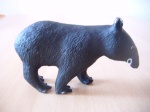
Country/State : Germany
Age : 48
Joined : 2010-12-30
Posts : 44548
 |  Subject: Re: Mathison Museum of Natural History Subject: Re: Mathison Museum of Natural History  Mon Nov 20, 2023 7:24 pm Mon Nov 20, 2023 7:24 pm | |
| |
|
  | |
bmathison1972
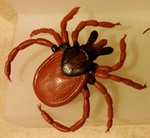
Country/State : Salt Lake City, UT
Age : 52
Joined : 2010-04-13
Posts : 6317
 |  Subject: Re: Mathison Museum of Natural History Subject: Re: Mathison Museum of Natural History  Tue Nov 21, 2023 12:54 pm Tue Nov 21, 2023 12:54 pm | |
| Species: Apalopteron familiare (Kittlitz, 1830) Common name(s): Bonin white-eye About the Figure: Manufacturer: Kaiyodo Series: Natural Monuments of Japan Year of Production: 2003 Size/Scale: Body length approximately 7.0 cm for a scale of 1:1.7-1:2 Frequency of species in toy/figure form (at time of posting): Very rare Miscellaneous Notes: Some assembly is required (the legs of the bird are permanently affixed to the fruit base). Kaiyodo also produced this species for the Chocoegg Animatales line and Kitan Club produced it for their Osagawara collection in the Nature Techni Colout line. About the Animal: Geographic distribution: Japan (Bonin Islands) Habitat: Lowland evergreen and broadleaf forests, forest edges, plantations, gardens; breeding usually occurs in undisturbed forest with bamboo, large trees and shrubs, and tree ferns Diet: Fruit, seeds, flowers, nectar, insects IUCN Status (at time of posting): Near Threatened Miscellaneous Notes: Like many white-eyes, Apalopteron familiare has a restricted distribution on certain Pacific Islands. The bird was once found on all major groups of islands in the Bonin chain, including the Mukojima Group, the Chichijima Group, and the Hahajima, but is currently restricted to Hahajima Island and two nearby islands. It's disappearance from several islands is due to habitat destruction and predation by introduced cats and rats and possibly competition with introduced warbling white-eyes. Apalopteron is a monotypic genus containing only the Bonin white-eye. Molecular analysis in 2019 showed that Apalopteron is nested within the white-eye genus Heleia, but avian nomenclatural authorities do not recognize this combination as of yet. [You must be registered and logged in to see this image.] |
|
  | |
widukind

Country/State : Germany
Age : 48
Joined : 2010-12-30
Posts : 44548
 |  Subject: Re: Mathison Museum of Natural History Subject: Re: Mathison Museum of Natural History  Tue Nov 21, 2023 1:27 pm Tue Nov 21, 2023 1:27 pm | |
| A figure from one of the best ever |
|
  | |
Caracal
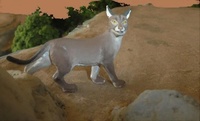
Country/State : France
Age : 65
Joined : 2018-10-24
Posts : 6978
 | |
  | |
landrover
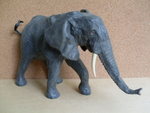
Country/State : colombia
Age : 66
Joined : 2010-11-04
Posts : 5766
 | |
  | |
bmathison1972

Country/State : Salt Lake City, UT
Age : 52
Joined : 2010-04-13
Posts : 6317
 | |
  | |
bmathison1972

Country/State : Salt Lake City, UT
Age : 52
Joined : 2010-04-13
Posts : 6317
 |  Subject: Re: Mathison Museum of Natural History Subject: Re: Mathison Museum of Natural History  Wed Nov 22, 2023 12:44 pm Wed Nov 22, 2023 12:44 pm | |
| Species: Mantis religiosa (Linnaeus, 1758) Common name(s): praying mantis; European mantis About the Figure: Manufacturer: Safari Ltd. Series: Hidden Kingdom Insects Year of Production: 2000 Size/Scale: Body length approximately 11.5 cm for a scale of 2.3:1-1.5:1 Frequency of species in toy/figure form (at time of posting): Common Miscellaneous Notes: This is the third time we've seen M. religiosa in the Museum. Wires in the prothorax and front legs allow the figure to be oriented into slightly different postures. This figure was a follow-up to the Smithsonian Insects praying mantis produced in 1995, which was larger and not bendable. About the Animal: Geographic distribution: Southern Europe, Asia, North Africa; introduced to Australia and North America Habitat: Forests, grasslands, agricultural fields, disturbed areas, parks, gardens; usually in areas with shrubby vegetation Diet: Insects IUCN Status (at time of posting): Least Concern Miscellaneous Notes: Mantis religiosa is an ambush predator and will pounce on any potential passing prey, within a manageable size, using its raptorial front legs. Cannibalism is common. [You must be registered and logged in to see this image.] |
|
  | |
Roger
Admin
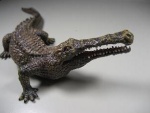
Country/State : Portugal
Age : 49
Joined : 2010-08-20
Posts : 35094
 |  Subject: Re: Mathison Museum of Natural History Subject: Re: Mathison Museum of Natural History  Thu Nov 23, 2023 12:52 am Thu Nov 23, 2023 12:52 am | |
| I didn't know that figure could adopt different postures.
I must check if you already posted the new Papo to see if it is a lifesized one. |
|
  | |
bmathison1972

Country/State : Salt Lake City, UT
Age : 52
Joined : 2010-04-13
Posts : 6317
 |  Subject: Re: Mathison Museum of Natural History Subject: Re: Mathison Museum of Natural History  Thu Nov 23, 2023 3:44 am Thu Nov 23, 2023 3:44 am | |
| - Roger wrote:
- I didn't know that figure could adopt different postures.
I must check if you already posted the new Papo to see if it is a lifesized one. [You must be registered and logged in to see this link.] - it's not in this thread yet, but I reviewed it on the Blog and calculated it as 1:1 for a large female or slightly larger than 1:1 for a male. |
|
  | |
Roger
Admin

Country/State : Portugal
Age : 49
Joined : 2010-08-20
Posts : 35094
 |  Subject: Re: Mathison Museum of Natural History Subject: Re: Mathison Museum of Natural History  Thu Nov 23, 2023 11:24 am Thu Nov 23, 2023 11:24 am | |
| - bmathison1972 wrote:
- Roger wrote:
- I didn't know that figure could adopt different postures.
I must check if you already posted the new Papo to see if it is a lifesized one.
[You must be registered and logged in to see this link.] - it's not in this thread yet, but I reviewed it on the Blog and calculated it as 1:1 for a large female or slightly larger than 1:1 for a male. Thanks, I checked the blog entry and those are good news. A female is what we expect from a Mantis. There is a a very good picture to count the abdominal segments. Apparently they are 6 so it is a female, it should be 8 for a male. Could you check it please, I'm not sure I'm doing it right. |
|
  | |
bmathison1972

Country/State : Salt Lake City, UT
Age : 52
Joined : 2010-04-13
Posts : 6317
 |  Subject: Re: Mathison Museum of Natural History Subject: Re: Mathison Museum of Natural History  Thu Nov 23, 2023 1:53 pm Thu Nov 23, 2023 1:53 pm | |
| [You must be registered and logged in to see this link.] - the Papo mantis has 8 abdominal segments; also is longer and slender with longer wings, so probable a male Next up: Species: Danaus plexippus (Linnaeus, 1758) Common name(s): monarch; milkweed butterfly About the Figure: Manufacturer: Cadbury Series: Yowies UK Series 1; Yowies Series 5 Years of Production: 1997; 2000 Size/Scale: Wingspan of both figures approximately 6.0 cm for a scale of 1:1.4-1:1.8 Frequency of species in toy/figure form (at time of posting): Common Miscellaneous Notes: This is the ninth time we have seen D. plexippus in the Museum. The figure on the right was produced by Cadbury for the first UK Yowies series in 1997; it is a solid piece of plastic. The figure on the left was produced by Cadbury for the fifth Australian Yowies series in 2000; assembly is required. About the Animal: Geographic distribution: North, Central, and South America, the Caribbean, the Azores, Canary Islands, North Africa, Australia, Philippines, and South Pacific islands; rare stray to the United Kingdom Habitat: Fields, forests, parks, gardens, disturbed areas Diet: Larvae feed on milkweeds in the family Apocynaceae, especially members of the genus Asclepias; adults take nectar from a variety of flowers IUCN Status (at time of posting): Least Concern Miscellaneous Notes: Populations of D. plexippus in Australia are believed to be descended from butterflies that arrived from Hawaii in the late 1800s; it was first reported breeding in Australia in 1871. Populations in Hawaii are believed to have arrived there in 1845 from mainland North or Central America. [You must be registered and logged in to see this image.] |
|
  | |
Roger
Admin

Country/State : Portugal
Age : 49
Joined : 2010-08-20
Posts : 35094
 |  Subject: Re: Mathison Museum of Natural History Subject: Re: Mathison Museum of Natural History  Thu Nov 23, 2023 7:26 pm Thu Nov 23, 2023 7:26 pm | |
| - bmathison1972 wrote:
- [You must be registered and logged in to see this link.] - the Papo mantis has 8 abdominal segments; also is longer and slender with longer wings, so probable a male
Thanks! so I think it is relatively safe to assume it is a male then. |
|
  | |
widukind

Country/State : Germany
Age : 48
Joined : 2010-12-30
Posts : 44548
 |  Subject: Re: Mathison Museum of Natural History Subject: Re: Mathison Museum of Natural History  Thu Nov 23, 2023 8:50 pm Thu Nov 23, 2023 8:50 pm | |
| |
|
  | |
bmathison1972

Country/State : Salt Lake City, UT
Age : 52
Joined : 2010-04-13
Posts : 6317
 |  Subject: Re: Mathison Museum of Natural History Subject: Re: Mathison Museum of Natural History  Fri Nov 24, 2023 1:45 pm Fri Nov 24, 2023 1:45 pm | |
| Species: Austruca lactea (De Haan, 1835) Common name(s): milky fiddler crab About the Figure: Manufacturer: Wing Mau Series: Aquatic Museum Year of Production: unknown Size/Scale: Carapace width 2.5 cm for a scale of 2.7:1-1.3:1 Frequency of species in toy/figure form (at time of posting): Very rare Miscellaneous Notes: There are six figures in the Aquatic Museum collection, each representing a different species of Japanese crab. Each comes with a flat habitat-style base (see inset); the six bases connect to form a larger base incorporating different habitats for each of the species in the set (see here. The only other figure of this species I am aware of was produced by Epoch for their Earth Life Journey Crabs and Shrimp collections. About the Animal: Geographic distribution: West Pacific Habitat: Upper intertidal mudflats Diet: Organic matter in sediment, carrion (including conspecifics) IUCN Status (at time of posting): Not Evaluated Miscellaneous Notes: A 2016 study looking at nuclear 28S rDNA, the mitochondrial 16S rRNA, and cytochrome oxidase subunit I (cox I) resulted in dividing the species-rich genus Uca (104 species) into 11 genera that fall within two subfamilies. In this new classification, Austruca appears basal within Gelasiminae, which also contains the genera Paraleptuca, Cranuca, Gelasimus, Xeruca, Minuca, Leptuca, Petruca, and Tubuca. Uca sens. str. and Afruca are in the subfamily Ocypodinae along with the ghost crabs ( Ocypode). [You must be registered and logged in to see this image.] |
|
  | |
bmathison1972

Country/State : Salt Lake City, UT
Age : 52
Joined : 2010-04-13
Posts : 6317
 |  Subject: Re: Mathison Museum of Natural History Subject: Re: Mathison Museum of Natural History  Sat Nov 25, 2023 1:35 pm Sat Nov 25, 2023 1:35 pm | |
| Species: Triakis semifasciata Girard, 1855 Common name(s): leopard shark About the Figure: Manufacturer: Safari Ltd. Series: Wild Safari Sealife Year of Production: 2007 Size/Scale: Body length approximately 14.0 cm for an average scale of 1:8.6-1:11.4 or 1:14 for a maximum-sized specimen Frequency of species in toy/figure form (at time of posting): Uncommon Miscellaneous Notes: This is Safari's second standard-sized leopard shark, following the original WS Sealife figure from 1997. About the Animal: Geographic distribution: West Coast of North America, from Oregon to Baja California Habitat: Coastal bays, estuaries, kelp forests, rocky reefs; at depths of 0-156 meters Diet: Benthic marine invertebrates, small fish (including young sharks), fish eggs IUCN Status (at time of posting): Least Concern Miscellaneous Notes: Triakis semifasciata is gregarious and travels in schools that are usually segregated based on size and sex. Leopard sharks may travel with other chondrichthyians, such as bat rays and smoothhound sharks. [You must be registered and logged in to see this image.] |
|
  | |
widukind

Country/State : Germany
Age : 48
Joined : 2010-12-30
Posts : 44548
 |  Subject: Re: Mathison Museum of Natural History Subject: Re: Mathison Museum of Natural History  Sat Nov 25, 2023 2:06 pm Sat Nov 25, 2023 2:06 pm | |
| |
|
  | |
Caracal

Country/State : France
Age : 65
Joined : 2018-10-24
Posts : 6978
 | |
  | |
bmathison1972

Country/State : Salt Lake City, UT
Age : 52
Joined : 2010-04-13
Posts : 6317
 |  Subject: Re: Mathison Museum of Natural History Subject: Re: Mathison Museum of Natural History  Sun Nov 26, 2023 2:32 pm Sun Nov 26, 2023 2:32 pm | |
| Species: Macropinna microstoma Chapman, 1939 Common name(s): barreleye; spookfish About the Figure: Manufacturer: Colorata Series: Deep Sea Fish Year of Production: 2015 Size/Scale: Body length approximately 6.5 cm for a scale of 1:1.5-1:2.3 Frequency of species in toy/figure form (at time of posting): Very rare Miscellaneous Notes: Some assembly is required (and getting the transparent cap over the head isn't an easy task) and the fish is removable from its base. This species wasn't in the original 2009 release of this collection. I am aware of at least three other figures of this species, one by Takara Tomy A.R.T.S and two by Kaiyodo (although the two Kaiyodo figures may use the same, if not very similar, sculpts). About the Animal: Geographic distribution: North Pacific; from the Bering Sea to Japan in the West and Baja California in the East Habitat: Mesopelagic to bathypelagic, at depths of 16-1,267 meters (commonly 600-800 meters) Diet: Small fish, cnidarians; possible kleptoparasite on siphonophores IUCN Status (at time of posting): Not Evaluated Miscellaneous Notes: Macropinna microstoma is best known for the transparent, fluid-filled shield on its head. Within the shield, the fish possesses two tubular eyes which can be rotated from dorsally-directed to rostrally-directed positions. The unique structure of the eyes is believed to enhance the fish's ability to perceive and capture prey in dim light and the shield may provide eye protection from the stinging tentacles of cnidarians that the barreleye feeds on. [You must be registered and logged in to see this image.] |
|
  | |
Caracal

Country/State : France
Age : 65
Joined : 2018-10-24
Posts : 6978
 |  Subject: Re: Mathison Museum of Natural History Subject: Re: Mathison Museum of Natural History  Sun Nov 26, 2023 3:19 pm Sun Nov 26, 2023 3:19 pm | |
| |
|
  | |
bmathison1972

Country/State : Salt Lake City, UT
Age : 52
Joined : 2010-04-13
Posts : 6317
 |  Subject: Re: Mathison Museum of Natural History Subject: Re: Mathison Museum of Natural History  Mon Nov 27, 2023 1:37 pm Mon Nov 27, 2023 1:37 pm | |
| Species: Plecotus auritus (Linnaeus, 1758) Common name(s): brown long-eared bat; common long-eared bat About the Figure: Manufacturer: Papo Series: Wild Animals Year of Production: 2018 Size/Scale: Wingspan of figure as positioned approximately 10.5 cm. Using forearm length as a metric (n=2.0 cm), scale comes to 1:1.8-1:2.1 Frequency of species in toy/figure form (at time of posting): Rare Miscellaneous Notes: I originally had the Kaiyodo figure to represent this species, but now that the Japanese population is considered a separate species, I was able to obtain the Papo model. About the Animal: Geographic distribution: Europe, east to the Ural and Caucasus Mountains Habitat: Boreal evergreen, deciduous, and mixed woodlands, orchards, parks, gardens, human habitations; roosting usually occurs in hollow trees, caves, barns, stables, mineshafts, under roofs, lofts, and underground crevices Diet: Insects, especially moths IUCN Status (at time of posting): Least Concern Miscellaneous Notes: Like many other bats, P. auritus can echolocation to detect prey. The frequencies used by the species lie between 27–56 kHz, have most energy at 35 kHz and have an average duration of 2.5 ms. However, unlike most bats, P. auritus is capable by hunting by sound alone and doesn't rely solely on echolocation. [You must be registered and logged in to see this image.] |
|
  | |
Caracal

Country/State : France
Age : 65
Joined : 2018-10-24
Posts : 6978
 | |
  | |
Jill

Country/State : USA
Age : 39
Joined : 2021-04-13
Posts : 2236
 |  Subject: Re: Mathison Museum of Natural History Subject: Re: Mathison Museum of Natural History  Mon Nov 27, 2023 3:56 pm Mon Nov 27, 2023 3:56 pm | |
| That bat is such a cool model, and the leopard shark is lovely. The barreleye is such a crazy animal, very cool to have a figure of it!! |
|
  | |
widukind

Country/State : Germany
Age : 48
Joined : 2010-12-30
Posts : 44548
 |  Subject: Re: Mathison Museum of Natural History Subject: Re: Mathison Museum of Natural History  Mon Nov 27, 2023 5:35 pm Mon Nov 27, 2023 5:35 pm | |
| |
|
  | |
Roger
Admin

Country/State : Portugal
Age : 49
Joined : 2010-08-20
Posts : 35094
 |  Subject: Re: Mathison Museum of Natural History Subject: Re: Mathison Museum of Natural History  Tue Nov 28, 2023 2:24 am Tue Nov 28, 2023 2:24 am | |
| I love this bat figure, it is very realistic looking and it also offers an organic sensorial experience. Superb model in my opinion. |
|
  | |
bmathison1972

Country/State : Salt Lake City, UT
Age : 52
Joined : 2010-04-13
Posts : 6317
 |  Subject: Re: Mathison Museum of Natural History Subject: Re: Mathison Museum of Natural History  Tue Nov 28, 2023 12:48 pm Tue Nov 28, 2023 12:48 pm | |
| Species: Lucanus maculifemoratus Motschulsky, 1861 Common name(s): Miyama stag beetle About the Figure: Manufacturer: Epoch Series: Flying Beetles Year of Production: 2004 Size/Scale: Wingspan approximately 11.0 cm. Body length (including mandibles) approximately 6.6 cm, within scale 1:1 and closer to 1:1.2 for a large major male Frequency of species in toy/figure form (at time of posting): Common Miscellaneous Notes: This is our seventh look at L. maculifemoratus in the Museum. Some assembly is required and the beetle can be removed from its base. About the Animal: Geographic distribution: Northeast Asia, including China, Taiwan, Korean Peninsula, eastern Russia, Japan Habitat: Forests Diet: Larvae feed in rotting wood and detritus; adults feed on tree sap. IUCN Status (at time of posting): Not Evaluated Miscellaneous Notes: As major male lucanid beetles get larger in size and possess larger mandibles, there is an inverse effect in the efficiency of locomotion. Flight is also costly, due to the added weight, but not nearly as high as walking. As such, flying is still the most efficient means to get to females and breeding sites. A 2015 study using Cyclommatus showed that while walking is 40% more costly, a major male, even with heavy armature, must deliver 26% more mechanical work to fly. Interestingly, the extra work is due to the weight; not size or shape of the mandibles. [You must be registered and logged in to see this image.]
Last edited by bmathison1972 on Tue Nov 28, 2023 10:57 pm; edited 1 time in total |
|
  | |
Sponsored content
 |  Subject: Re: Mathison Museum of Natural History Subject: Re: Mathison Museum of Natural History  | |
| |
|
  | |
| | Mathison Museum of Natural History |  |
|
